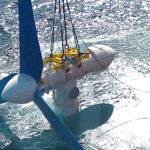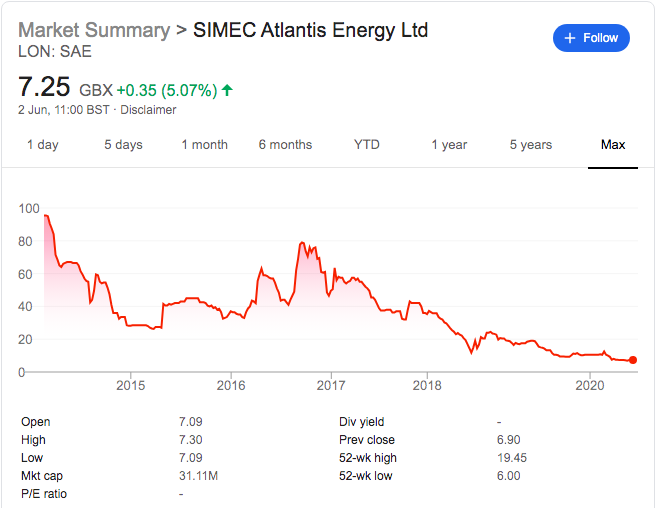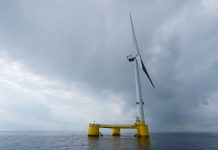 Simec Atlantis CEO Tim Cornelius thinks the firm’s share price, just seven per cent of its 2014 IPO, is “set for the mother of all corrections”.
Simec Atlantis CEO Tim Cornelius thinks the firm’s share price, just seven per cent of its 2014 IPO, is “set for the mother of all corrections”.
His confidence is predicated partially on hopes of a clean run at government contracts for difference that look set to be ring-fenced so that offshore wind is in a class of its own, leaving less mature technologies with a better chance of winning.
Landing one of those contracts, says Cornelius, will enable the firm to “get to financial close on 80MW of tidal power”. It would also green light construction of a data centre powered by tidal energy and a private wire, which Cornelius, says could be operational by 2023.
He thinks the data centre will go ahead “regardless” of whether Atlantis lands the CfD. “There’s a lot of political momentum behind it,” says Cornelius, given Scotland’s push for digital independence.
But the prime mover of his predicted price boom is Uskmouth, where the firm is attempting to convert a coal-fired power station to burn non-recyclable waste.
Attitude adjuster

“The share price is a complete anathema,” says Cornelius, who has spent 14 years at the helm. “The dislocation between the value of the company and the share price is primarily reflected by the structure of its holding.”
The vast majority, he says, is held by “non-trading” long-term holders. But that means “a few retail investors can change your fortunes by trading £1,000 worth of stock, which is infuriating, given we have never issued a profit warning or missed a target.”
But Cornelius insists the tide will turn, and that the price “is set for the mother of all corrections”.
The value of the tidal business alone “is multiple orders of magnitude of the market cap, so we anticipate a moment of awakening,” he says.
“As soon as we achieve financial close on Uskmouth … you will see an immediate correction.”

Uskmouth
Achieving financial close requires planning, permitting and consenting, which Cornelius claims are “going very well.” The company last week launched a pre-application consultation on its plans, which have switched away from producing the ‘subcoal’ waste-derived pellets onsite, to bringing them in via rail, which will require significant new infrastructure. Atlantis hopes Newport City Council will make a decision on its application by Q4 this year.
Technology-wise, he says the burn test results, being undertaken by Mitsubishi Hitachi Power Systems Europe at the site, are due in days. Volume production and milling tests of the subcoal pellets were published in March.
“I’m not sure if people understand the implications [of Uskmouth],” says Cornelius. “It is not a technology risk. We have created a fuel that can be used as a substitute for coal. Mitsubishi Hitachi burners are used in hundreds of coal stations and the fuel can be used in each of those burners. So the implications for us, Hitachi and GE and others are huge.”
Once those burn tests are complete, Cornelius predicts a “glide path to the end of the year to be pulling together financial close”.
While the energy-from-waste sector is heating up, illustrated by KKR’s £4.2bn acquisition of Viridor from Pennon, Cornelius claims Uskmouth puts Simec Atlantis in a category of one.
“The energy-from-waste boom is creating competition for black-bag waste. But the non-recyclable bit is what nobody knows what to do with – don’t think straws, think car dashboards,” says Cornelius.
“China has shut the gates, followed by Malaysia, then Poland and the Netherlands. So there is a substantial increase in disposal costs. But that waste is what we take [to make the fuel pellets],” he says. “So we provide a route to market that is not in competition with all the existing EfW plants.”
Meanwhile, he says the technology will allow existing coal plants to stay open. As such, the company is in “advanced negotiations” with operators in both the UK and Europe and has “hosted parties from Asia and North America,” says Cornelius.
“Anyone that owns a coal-fired generation asset has to make a decision – either shut it down or try and convert it. Some of the Chinese and Japanese asset owners have tens of plant and they face huge decommissioning costs,” says Cornelius. “In Europe, operators like EPH have been buying up coal stations across the continent.”
As such, Uskmouth is of “substantial interest” to that class of operator, he says.
Tidal power and floating wind
In a consultation in March, government sought views on its plans to separate offshore wind into a separate pot for contracts for difference (CfDs), the UK’s main renewable generation incentive scheme.
CfD winners secure a set price for power via 15-year government contracts. The auction-based mechanism reduces market risk and enables developers to finance projects. To date it has driven down the cost of offshore wind, but less mature technologies cannot compete on cost.
Whether tidal power can ever compete with offshore wind on price is questionable. But the government wants optionality, to not put all of its eggs into one basket. If it confirms the decision to split off offshore wind into a third ‘pot’, it will leave technologies such as floating wind and tidal power competing with each other to secure funds. Cornelius thinks Atlantis will be the biggest winner.
“There are hardly any consented floating offshore wind projects. So we will get a much better run at competing [in the 2021 auction],” says Cornelius. “They will all be aiming for 2023-25. We have a fully consented project.”
However, when floating wind does “get going”, Cornelius says developers will be customers for its subsea hub, essentially an offshore multi-socket plug point. He says the company is “close” to sealing deals to connect floating offshore wind demonstrator projects.
Tidal powered data centre
Cornelius says the Caithness data centre project “has piqued investor interest from all over the world” as operators seek to reduce their carbon footprints. Meanwhile, he says the Scottish government is keen to become digitally independent as it regroups for a second shot at becoming a fully independent nation.
Whereas the UK has more than 50 major fibre optic connections to the outside world, Scotland has one, says Cornelius – and relatively little data centre capacity.
The plan for the Caithness project is to link both via the FARICE cable to Iceland and the new Celtic Norse cable, connectivity that Cornelius says will be attractive to developers.
“So we have fibre connections and an existing grid connection, which gives us a huge advantage,” says Cornelius. “We are doing all of the pre-work in terms of planning and application. After the CfD auction results, we hope to get to financial close on 80MW of tidal power, and then … 2022 for construction and 2023 for full operations. But I think it will go ahead regardless, there is a lot of momentum behind it.”
Tide turning?
Atlantis’ original tidal project, MayGen, has clocked up close to 30GWh. The firm is now upgrading the Atlantis turbine (the 6MW project uses three AAH turbines and one designed and built by Atlantis) and Cornelius hopes that will go back in the water this month.
“It has performed above expectation, with huge reliability,” says Cornelius. Two years of commercial operations, he says, have given buyers confidence.
“After 20GWh, people started placing orders, because it is de-risked,” he says, pointing to a deal earlier this year to supply and install a 500kW turbine off Nagasaki for Japanese utility KME. Cornelius is hopeful more sales will follow in the archipelago.
Meanwhile China is now looking seriously at tidal energy, with Simec Atlantis involved in the design of a 500kW turbine installed near Wuhan in April.
“They went from sketch to installed in 18 months, which is unheard of,” says Cornelius.
“Hopefully that will roll on and grow the market globally.”
Related stories:
Atlantis lands grant for tidal hub
Atlantis floats tidal powered data centre
Think big to make tidal power ‘cheaper than Hinkley C’, says Atlantis boss
Atlantis 6MW tidal array enters commercial operations
Atlantis plans 160MW Wyre tidal barrage
Scotland sets world record for tidal power
Atlantis predicts big year for tidal power
Engineers tell government to pay for tidal power
Government confirms support rates for offshore wind, wave and tidal power
Tidal energy firms clocks up 1GWh, seeks more funds
Simec Atlantis fundraising for waste-to-energy and tidal projects
Simec agrees Uskmouth stake sale terms, shares soar
Simec eyes 900,000 tonnes of UK waste fuel production
Simec hires Drax expert to help with Uskmouth conversion
Simec Atlantis steps up Uskmouth conversion plans
Follow us at @EnergystMedia. For regular bulletins, sign up for the free newsletter.




First of all:
When and where did Tim Cornelius say this?
Second:
This speculation is a very long shot. If you read the document published by the government, you’ll see that SIMEC Atlantis (SAE) still has to compete against floating offshore wind in both cases. Pot 2 contains tidal stream and floating offshore wind hence it is still very likely that they won’t be able to secure the funding as floating offshore wind is much cheaper than tidal stream energy.
I do own a few shares of SIMEC Atlantis myself and I do wish, for obvious reasons, that those shares skyrocket but after doing a lot of research, I have a fair share of doubts as well that SAE will be successful in AR4 of Contracts for Difference (CfD).
In a phone interview, last week. As for the rest, as any investor knows, your own research guides your hand. There are probably some other key questions around ownership and investment too. He’s unlikely to talk it down, but that’s what the CEO had to say. His view was that the CfD pot split was probably the most interesting new angle, given ‘floaters’ have not got consents. Time will tell.
Thank you for clarification!
I noticed that my comment above sounds a bit unfriendly/harsh. It’s not meant that way. I am currently researching renewables and therefore also SAE. I do like this company for several reasons and I really do hope that tidal energy can set foot in this (hopefully) emerging market. However, I am not as optimistic regarding AR4 of CfD. These contracts are awarded for long-term utility-scale projects which can deliver the most “bang for the buck”. I know, this is not entirely true but at some level it is. We’ll see how this goes in 2021, I guess. I am rooting for SAE but I really do see how floating offshore wind is a big competition. We have to hope that their projects abroad do in fact help lowering the cost. It would have been interesting to know where the cost per MWh is currently at for SAEs turbines as compared to floating offshore wind and what they think they can achieve in the next round.
BR;